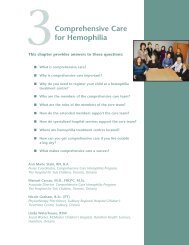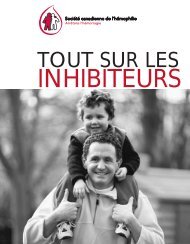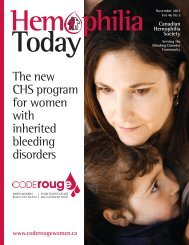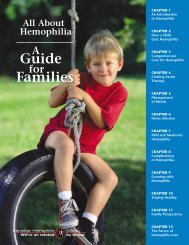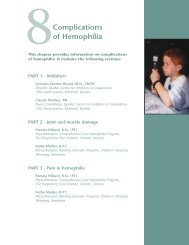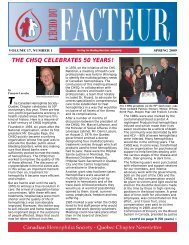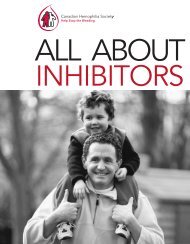Download
Download
Download
- No tags were found...
You also want an ePaper? Increase the reach of your titles
YUMPU automatically turns print PDFs into web optimized ePapers that Google loves.
HEMOPHILIA TODAY PHYSICAL FITNESSSUMMER 2002AND BLEEDING DISORDERS13EditorialIt’s Never Too Late to Get MovingKathy MulderPhysiotherapist, Children’s Hospital, WinnipegThe statistics are alarming:■ 40% of North American children 5 to 8 years of age are obese.■ The average Canadian child watches more than 26 hours of television and spendsup to 30 hours sitting in school each week.■ Children are spending more time playing video games and using computers.■ 30% of North American adults are obese.■ Between 50 and 60% of adults over 25 are overweight.■ 57% of Canadian adults aged 18 and older are considered insufficiently active foroptimal health benefits.We know that exercise is important for weight control, and that it can prevent heartdisease, depression, cancer and diabetes.There are other reasons why exercise and physical activity are especially importantfor people with hemophilia. Strong muscles protect the joints from twists and strains,exercise develops coordination to prevent falls and injuries, and exercise enhancesoverall well being.Selecting exercises and fitness activities that are safe for people with hemophilia canbe a challenge but it is not impossible. Making regular physical activity a part of one’sdaily schedule is at least as important as eating vegetables and remembering to floss!Do we get enough exercise? No. Is it too late to start? Never!But what about some of the complications that can go along with hemophilia?Target joints, chronic hepatitis, and inhibitors can make selecting and participating inphysical activities even more of a challenge. These situations require careful assessmentand regular communication between the hemophilia treatment team and theindividual.Sports, fitness, activity, exercise - these can all mean different things to differentpeople. We can’t all be Lance Armstrong. But we can all find activities to help us feelstrong and fit.In this feature on exercise and fitness, I have tried to address some of the manyaspects of physical activity for people with bleeding disorders. How do parents helptheir child to choose a safe sport? How can they balance the need for safety with theinevitable need to be part of the crowd? What is it like to feel different because youcan’t participate with your friends? How can you minimize the risks when you dochoose an activity? What activities are recommended? And why are some things NOTrecommended when they seem like so much fun? What if a person has an inhibitor?And finally, what can you do if you want to start an exercise program but you can onlysee the physiotherapist once a year?Of course, before you start an exercise program you MUST discuss your plans withyour hemophilia treatment team. And, if you would like additional information, lookup these sources:■■■■Canada’s Physical Activity Guide for Youth, published by Health Canada.Call 1-888-334-9769 or visit www.healthcanada.ca/paguidewww.nlm.nih.gov/medlineplus/exercisephysicalfitness.htmlhttp://kidshealth.org/parent/nutrition_fit/index.htmlwww.americanheart.org/presenter.jhtml?identifier148I hope that these articles will inspire you to get moving!Helping your child makehealthy choicesBut Mom!Everybody Elseis Playing…One of the toughest jobs when oneis a parent is to set and enforcelimits. When your child hashemophilia, these limits can sometimesmean the difference between health andinjury. As parents, we need to usejudgment, anticipate problems before theydevelop and think of the future for ourchildren. Sometimes this means that ourchildren think we are the meanest parentsin the whole world!An area of serious conflict can be theselection of sports and activities for yourchild. You know (or have been told) thatcertain sports are not recommended foryour child with hemophilia. But what if hisbrothers and sisters and friends are allplaying those sports? Children do NOTwant to be left out of the group, or worse,teased and ostracized because they can’tparticipate. How can you encourageinclusion while preventing injury?Isla Crawford is a Certified Child LifeSpecialist. She offers these suggestions.First, find out what is popular in yourcommunity. If EVERYBODY plays hockey,it can be tough. But are there other thingsfor the kids to do? If you look around, youmight be able to find another activity thatwasn’t apparent at first. There might be anolder role model for your son who doesthis activity. Or get your own grouptogether. Make this activity THE COOLthing to do.When your child is small, try to get himinterested in a suitable activity such asswimming or non-contact Tae Kwon Do. Ifhe is really hooked, it won’t be such anissue when “the other kids” start playinghockey—he’ll be too busy to notice!What can you do as a family? Cycling,swimming, hiking and canoeing are allactivities that the whole family can dotogether. Your son can usually participateThe illustrations in this section are reprinted from Go For It! published by the World Federation of Hemophilia



